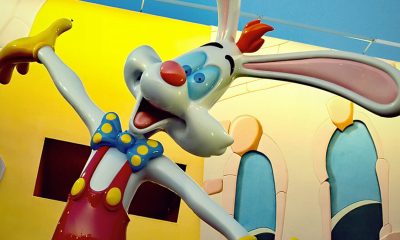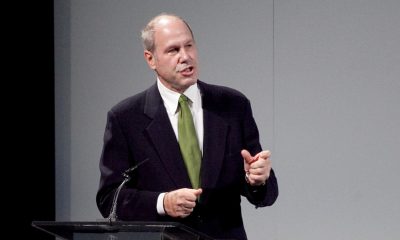Film & Movies
The Sad Tail … I mean “Tale” … of the Stalled Roger Rabbit Sequel
In this piece from the Jim Hill archives, learn why you shouldn’t expect a return trip to ToonTown anytime soon…
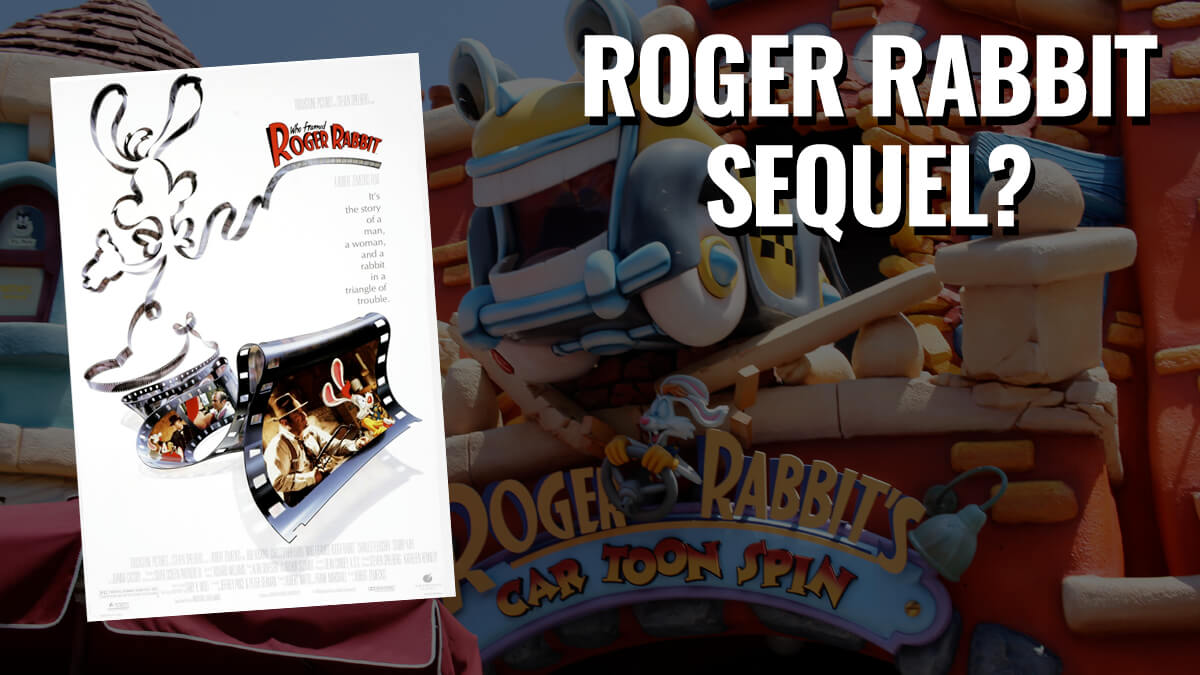
Now that Peter Schneider — former head of feature animation — is the new chairman of Walt Disney Studios, does that mean his old buddies at Feature Animation will get preferential treatment?
Not bloody likely.
Peter Schneider – Chairman of Walt Disney Studios
Schneider is a true corporate creature, folks. The moment he took over for former Disney studio head Joe Roth, all loyalty to Disney Feature Animation [DFA] ended abruptly. Now Peter leans hard on his former charges to keep production costs down and productivity up.
Which is a shame. Because for a while there, some DFA staffers thought Schneider might do something positive with his new-found power.
Like — say — finally green-light a film that animation fans have been waiting twelve years for.
Will “Roger Rabbit II” Get Made?
But don’t hold your breath, folks. “Roger Rabbit II” isn’t going to happen anytime soon. Though the key pieces are already in place (A script — featuring five new Alan Menken songs — has been written. Menken himself has agreed to serve as the film’s executive producer. Master Disney animator Eric Goldberg has committed to supervising the animation of this project. Disney Feature Animation’s Florida unit even had staffers working on test footage last spring), this long awaited sequel to the 1988 blockbuster stalled out again last summer.
What happened? How is it that a film like “Roger Rabbit II” — a project that’s almost guaranteed to make money — keeps failing to get made?
Part of the problem is cost. Then there’s that deal Eisner made with Spielberg. Plus all the personality conflicts involved.
*Sigh* It’s a long story, folks. (I know, I know. ALL my stories are long stories. Sorry. I guess — when it comes to the history of the Walt Disney Company — there are no neat, short answers).
But — to understand why it is that a guaranteed blockbuster like “Roger Rabbit II” can’t get made — you have to go back over the unlikely chain of events that lead up to the original film getting produced in the first place.
Ron Miller Pushes for “Who Censored Roger Rabbit”
Roger Rabbit started on the road to screen stardom away back in 1980, when then-Disney Studio head Ron Miller got a hold of the galley proofs for a soon-to-be-published novel. This book — Gary Wolf’s “Who Censored Roger Rabbit” — was a clever spoof of all those old hardboiled detective novels. It was a twisted tale set in a film noir never-neverland; a Hollywood where humans and toons lived and worked uneasily side by side.
Miller thought that Walt Disney Productions could make something really special out of Wolf’s book. He brought the story to the attention of then-Disney CEO Card Walker. Walker was less than impressed. Finding the novel weird and dark, Card told Ron to pass on the project.
Miller didn’t. In fact — over Walker’s objections — Ron paid $25,000 for the film rights to “Who Censored Roger Rabbit.” Miller then handed the project off to a young Disney production executive, Mark Sturdivant, for development. Sturdivant hired two former advertising copywriters, Jeffrey Price and Peter Seaman, to work up a screenplay. He also assigned Disney animator Darrell Van Citters to begin roughing out character designs as well as pencil tests for the project.
“Who Framed Roger Rabbit” Script
Seaman and Price wrote ten different drafts of their Roger Rabbit screenplay before they finally got the story right. In the process, the screenwriters chucked out most of Wolf’s original storyline, while retaining most of his character names as well as the book’s core concept.
What made Seaman and Price’s final version of their Roger Rabbit screenplay so much fun is that they decided to go whole hog with Wolf’s “toons are real” idea. So they wrote a murder mystery set in 1947 Hollywood, where private detective Eddie Valiant didn’t just interact with Roger, Jessica and Baby Herman. He also had to rub elbows with Betty Boop, Bugs Bunny and tons of other established cartoon stars before he could solve the murder of R.K. Maroon.
It was a daring idea for a Disney film. One that that Miller and Sturdivant were sure Walt himself would have loved. But it was also a potentially pricey project. In order for the film to work, the Mouse needed to get clearances from several other Hollywood studios to use their classic cartoon characters.
Working With Other Studios
Now please remember that this was ‘way back in the early 1980s. Disney was not the media giant we know today. It was still an entertainment industry also-ran, best known for its fine theme parks and lame-ass movies.
Miller had Sturdivant approach Warner Brothers, Paramount and Universal about contracting their classic cartoon characters out to appear in “Who Framed Roger Rabbit.” They all just laughed, said no and/or asked for such ridiculously high fees that they made making a deal impossible.
Testing “Who Framed Roger Rabbit”
In spite of this setback, Miller still had Sturdivant and Citters continue work on “Roger Rabbit.” He ordered that live action footage be shot, so that pencil test animation could be layered over these scenes — to see if a toony Roger Rabbit could convincingly interact with a live action Eddie Valiant.
Early subscribers to the Disney Channel actually got a chance to see this footage on an April 1983 broadcast of “Disney Studio Showcase.” Hosted by animation historian John Culhane, this program (which also hyped the then-in-production film “Baby – Secret of the Lost Legend” as well as Tim Burton’s TV version of Hansel & Gretel) included a preview of “Who Framed Roger Rabbit.”
The test footage featured an unknown actor standing in for Eddie Valiant. After exiting an alley, Eddie is suddenly accosted by a giant cartoon police detective. He’s then shown drinking at a bar with an early version of Jessica (Who at this point in her development, wasn’t quite so voluptuous. This Jessica — who was supposed to be the villain in this version of the film — looked a lot like Cruella De Vil-gone-Hollywood). The segment ends with Culhane exiting the Roger Rabbit production offices, just before a fully animated and painted version of Roger strolled through this live action setting.
Spielberg/Zemekis Pass on “Roger Rabbit”
Miller was determined to get this film made. He sent the test footage as well as the Roger Rabbit script to Steve Spielberg, Robert Zemekis and Joe Dante for their review. Each of these directors was intrigued by the project. But they also doubted that tired old Disney Studios had what it took to get this sort of special effects extravaganza off the ground. Miller offered to put up a budget of $25 million. All three directors still passed on the picture.
Even in the face of these high profile rejections, Miller still pressed ahead with his plans for a Roger Rabbit feature. He had a picture of Roger placed in the 1983 Walt Disney Productions annual report, its caption reading “Work continues on the live action – animated Roger Rabbit.” Miller also authorized Citters to begin auditioning talent to voice Disney’s latest creation. Citters eventually selected a then-unknown comic from LA’s “Groundling” improvisation troupe. His name? Paul Reubens (a.k.a. Pee Wee Herman).
Miller kept plugging away at “Roger Rabbit,” trying relentlessly to get the movie made. He kept faith in the project right up until September of 1984, when the Walt Disney Company suddenly lost faith in him. That’s when Miller was unceremoniously forced out and Michael Eisner became the Big Cheese at the Mouse Factory.
Miller’s Out, Eisner’s In – And Where is “Roger”?
Quick cut to 1986: Eisner has been on board at Disney for a year or so now.
Having quickly thrown together a few live action films like “Down and Out in Beverly Hills” and “Ruthless People” that made money for the company, Uncle Mikey is anxious to do something more ambitious.
What does Eisner want to do? He wants Disney to produce a major motion picture. A film with a huge budget and tons of special effects. The sort of project that makes critics as well as moviegoers sit up and take notice. Something that could win awards as well as offer lots of opportunities to generate cash (toys, games, soundtrack albums, etc) for the company.
Eisner wanted to make something that would send a message to the rest of the entertainment world that Disney was no longer a Mickey Mouse operation.
In short, an event film. A blockbuster.
But where do you find a blockbuster? Particularly when you have next to no dough to develop such a thing?
Actually, then-Disney Studio head Jeffrey Katzenberg (a.k.a. the Golden Retriever) uncovered just such a project one day while reading through some old scripts Disney had previously put into development. ‘Way down deep in the pile, he discovered Seaman and Price’s screenplay for “Who Framed Roger Rabbit?” Sensing he’d struck the mother lode, Jeffrey quickly brought the script to Eisner’s attention.
Eisner read the “Who Framed Roger Rabbit?” screenplay and immediately realizes that this was the film he was looking for. Here was the ideal movie for Disney’s new production team to tackle as their first big budget project. Roger Rabbit had something for everyone: animation to draw in the small fry and their families, plus enough sly wit and action to keep adults and teenagers happy. This project had blockbuster written all over it. The big question was: Could Disney pull it off?
Classic Cartoon Characters and Spielberg
The only stumbling blocking for Eisner and the revived Roger Rabbit project was the same thing that tripped up Ron Miller: Getting the clearances from all those other Hollywood studios for use of their classic cartoon characters. Without those non-Disney 1940s era toons for Eddie to interact with, Roger Rabbit wouldn’t be special. The film would just fall flat.
But Eisner had a secret weapon: his personal and professional relationship with movie maestro Steven Spielberg.
Back in 1980, Spielberg and George Lucas had been looking for a home for their dream project: a big budget remake of the old Saturday matinee serials. It featured exotic locations, elaborate stunts as well as an unlikely sounding hero: Indiana Jones.
Based on Lucas and Spielberg’s box office reputation, every studio in town (including Disney) wanted a shot at producing “Raiders of the Lost Ark.” But none of them dared to take on the project, after they learned about the film’s projected budget as well as the outrageous financial terms Spielberg and Lucas were asking. Only Eisner — then head of production at Paramount Pictures — dared to make the deal.
That gamble had paid off handsomely, both in its profits for Paramount as well as Eisner’s friendship with Spielberg. So now — six years later — Eisner had his own dream project that needed help. So he called Steven at his Amblin production offices over on the Universal backlot, asking him to come on down to Burbank for a little confab.
Spielberg — of course — remembered the Roger Rabbit script and shared Eisner’s enthusiasm for the proposed film. But Steve also knew that this ambitious mix of animation and live action would be an expensive and time consuming project. It was almost too much film for one studio to make.
Disney Partners with Amblin
That’s when Eisner proposed that Disney and Amblin produced “Who Framed Roger Rabbit?” together. Disney would lend its animation expertise to the project. Steven would bring in his buddy, George Lucas and his wizards at ILM to handle the film’s special effects. More importantly, Spielberg could use his considerable clout to persuade the other Hollywood studios to allow the Mouse to use their classic cartoon characters in “Who Framed Roger Rabbit?”
Steven was willing to take Uncle Mikey on his offer — with one condition: Disney and Amblin had to share the copyright on any characters that were created for the film. That meant that the two companies would split everything right down the middle. 50 / 50. That included merchandising revenues, sequel and spin-off rights, any theme park projects, basically the whole ball of wax.
Eisner was so desperate to get his event film made that he quickly agreed to Spielberg’s terms. That may have been the last time Michael and Steven agreed on anything relating to “Roger Rabbit.”
Producing “Who Framed Roger Rabbit”
The actual production of “Who Framed Roger Rabbit?” is a classic Hollywood horror story.
A troubled film right from the start, its budget started at $30 million, then quickly escalated to $50.6 million.
Work on the movie fell so far behind schedule that — in February 1988 — it looked Roger Rabbit might miss its June 24th opening date. Since Disney had already signed multi-million dollar promotional deals with McDonalds and Coca Cola that keyed on Roger Rabbit opening on that day, missing the film’s opening date was not an option. So Uncle Mikey forced then-Disney studio head Jeffrey Katzenberg to personally take charge of the project. Jeffrey did everything he could think of — kicked, cried, screamed, cajoled — to get the Roger Rabbit team into meet their production deadline.
The one aspect of the project that did not go over-budget was the licensing deals Spielberg worked out for use of the non-Disney classic cartoon characters to be featured in the film. True to his word, Spielberg persuaded the other Hollywood studios to lease their toons to the Mouse for a ridiculously low fee: $5000 per character.
Bugs Bunny & Mickey Mouse in “Roger Rabbit”
Of course, there were a few conditions. Warners insisted that — if Bugs Bunny were to appear in the film — he could only appear in scenes where he performed directly opposite Mickey Mouse. And — when the characters spoke — Bugs had to have the same exact number of words of dialogue that Mickey did.
(Warners’ insistence on a similar arrangement for Donald and Daffy Duck actually resulted in one of the best scenes from “Who Framed Roger Rabbit?” Since Donald and Daffy had to appear together, director Robert Zemekis threw them on stage as a team at the Ink and Paint club. Their loony dueling pianos rendition of the “Hungarian Rhapsody” was one of the real highlights of the first film.)
“Roger Rabbit” is a Box Office Success
With Katzenberg cracking the whip, “Who Framed Roger Rabbit?” did actually make it into theaters on June 24th. The film immediately became a box office sensation — grossing over $154 million in its initial domestic release alone. Overseas, Roger Rabbit was even more popular, taking in $174 million at the international box office.
Disney and Spielberg had created a hugely popular movie. Consumers snatched up mounds of Roger Rabbit merchandise, then clamored for more. The film won four Academy Awards.
Fans screamed for a sequel.
But now — twelve years later — Roger languishes in limbo.
Will There Ever Be a “Roger Rabbit” Sequel?
The follow-up to this hit motion picture is almost a decade overdue. Plans for sure-fire Disney theme park attractions based on the characters (other than the one-off “Roger Rabbit’s Cartoon Spin” at Disneyland’s ToonTown) just lay around WDI, gathering dust.
What the hell happened? The answer lies in that 50 / 50 deal Eisner made with Spielberg. Both Disney and Amblin own half of the copyright on the characters created for “Who Framed Roger Rabbit?” That means — before any project involving Roger can move forward — both sides have to agree exactly on the exact terms of the contract. Every time Roger appears in a film or a theme park attraction or even on a toy, there’s a lengthy negotiation between Disney and Spielberg’s lawyers involved.
As you might imagine, this sort of micro-management takes up a lot of time — which is why Roger Rabbit’s career has been on hold these years past ten years.
Mind you, it wasn’t always like this. Back in 1989 — right after “Who Framed Roger Rabbit?” was released to universal acclaim and the film did boffo business at the box office — both Disney and Spielberg were anxious to cash in on the film’s popularity.
Roger Rabbit – Shorts and Disney-MGM Studios Attractions
So, hoping to keep the character fresh in the public’s mind, Disney quickly put a new Roger Rabbit short, “Tummy Trouble,” into production. Spielberg okayed the idea, as well as the Mouse’s plan to fold elements from the hit film into their then still-under-construction Disney-MGM Studios Theme Park.
“Roger Rabbit” Props at Disney-MGM Studios Theme Park
Guests who visited that park during its first year of operation may remember how prominently Roger Rabbit and friends were featured at the studio theme park. Folks who took the backstage tram tour rolled past many of the props used in the film, including Eddie Valiant’s roadster and a “Red Car” trolley. They even encountered a recreation of the Acme Warehouse, where they were menaced by the Dipmobile.
After exiting the tram, guests followed Roger’s large footprints into the Looney Bin. There, they could play among the props in the Acme Gagworks or have their picture taken cuddling with Jessica and / or careening around ToonTown inside Benny the Cab. Other “Who Framed Roger Rabbit?” props were featured prominently inside the Special Effects workshop.
“Tummy Trouble” Short
That summer, “Tummy Trouble” debuted in theaters nationwide. Audiences flocked to see the new short (as well as the feature film that followed it: “Honey, I Shrunk the Kids“). Given the response at the box office, it was obvious that Roger was no one hit wonder.
Is Roger Rabbit the Next Mickey Mouse?
Properly handled, it looked this rabbit could be a perennial. A character with legs. Someone like Mickey or Donald who could stay popular with audiences not for just a year, but for decades at a time. An evergreen money machine.
That was Disney’s goal, anyway. So — with the hope of keeping the “Roger Rabbit ” gravy train rolling — the Mouse quickly cut a deal with Spielberg to co-produce a sequel to the first film. They then announced that they’d be following up “Tummy Trouble” with a whole new series of Roger Rabbit shorts. The next installment, “Roller Coaster Rabbit,” would actually be produced at its Disney / MGM animation studio in Florida.
It all seemed too good to last.
It was.
It was actually the next short that started all the problems.
“Roller Coaster Rabbit”, “Arachnophobia”, and “Dick Tracy”
Spielberg wanted “Roller Coaster Rabbit” to be shown in front of a film Amblin was producing for the Walt Disney Company. (A little side note here: That film, “Arachnophobia,” was actually the first title to be released through Disney’s Hollywood Pictures division). On the other hand, Disney just blew $45 million making Warren Beatty’s troubled summer blockbuster, “Dick Tracy.”
Knowing that Beatty’s big screen comic book was going to need all the help it could get to make back its production costs, Disney wanted to put “Roller Coaster Rabbit” in front of “Dick Tracy.” (Why? Because — the previous summer — Disney’s “Honey, I Shrunk the Kids ” had made $124 million. Some people thought that the film had become a hit on its own. But there were an equally large number of folks at the studio who felt that “Honey” only did as well as it did because it had a new Roger Rabbit short showing in front of it.)
In the end, Disney got what it wanted. “Dick Tracy” — thanks in part to the Roger Rabbit short that ran in front of it — wasn’t exactly a hit, but it did make back its production costs. On the other hand, “Arachnophobia,” despite some great reviews, under-performed. (Making just $52 million, the movie barely covered its promotion and production costs.) It became obvious that that “Arachnophobia” could have really used the extra box office juice that would have come from having a new Roger rabbit short in front of it. But “Dick Tracy” and the Mouse had won that time …
Spielberg — a man who is used to getting what he wants — was upset at what he perceived as Disney’s slight. As a co-owner of Roger Rabbit, he felt that he should have had more of a say in how the character was being used — particularly concerning which short got put in front of which movie.
“Hare in My Soup” – Nothing Moves Forward Without Spielberg Approval
So Spielberg decided to make his position regarding Roger Rabbit and Disney clear. He waited ’til Disney actually had a new short, “Hare in My Soup,” in production. Then Spielberg announced “I don’t like the story for the new short. Without my approval, you can’t go forward with this film. Shut down production.”
Given that these were indeed the terms of the Roger Rabbit deal, Disney reluctantly halted work on “Hare in My Soup.” None of the other story ideas for shorts the Mouse pitched to Spielberg met his fancy either. As a result, there was no new Roger Rabbit short that year. (Not so co-incidentally, the film “Hare in My Soup” would have appeared in front of — “The Rocketeer” — which went on to under-perform at the box office. It could have really benefited from all the excitement having a new Roger Rabbit short.)
It would be two years before Spielberg would allow work to proceed on a new Roger Rabbit short, “Trail Mix-Up.”
“Who Discovered Roger Rabbit?” – “Roger Rabbit” Prequel
By then, Steven was also holding up production on a proposed sequel to the original feature film. Its title was to have been “Who Discovered Roger Rabbit?”
Steven’s explanation for stalling the Roger Rabbit feature length follow-up was that he had issues with Nat Mauldin’s screenplay. The script (which, by the way, wasn’t a sequel, but a prequel: its storyline took place well before the events featured in “Who Framed Roger Rabbit?”) dealt with Roger’s early days in Hollywood as he struggled to make it as a star.
There are several different storylines that ran through “Who Discovered Roger Rabbit?” One covered Roger’s courtship of Jessica. Another dealt with his search for his long-lost mother. And — because the film was set during World War II — still another story-line dealt with a popular radio host that Jessica worked for who was eventually revealed to be a Nazi spy.
Now keep in mind that we’re talking about Steven Spielberg circa 1993 here. This is a guy who’s just had a major spiritual awakening due to his work on “Schindler’s List.” Having embraced his Jewish heritage, Spielberg announced that — due to the atrocities his people had suffered during the Holocaust — he could no longer allow nazis to appear as stock villains in his films.
Okay. I can respect that. (Though — if I were a mean and petty person — I might point out that less than four years later, Spielberg did another film called “Saving Private Ryan.” And weren’t the villains in that movie, well, nazis? But I digress.)
Anyway, Spielberg says “No more Nazi villains in my movies.” Disney has to honor the request of the co-owner of the Roger Rabbit copyright. So they began reworking Mauldin’s script. The Nazi sub-plot got cut, but so did the film’s Hollywood setting. The time period shifts back a few years and…
Presto Changeo! What was once a World War II comic adventure was now a Busby Berkley movie musical. Now set in New York City during the depths of the Depression, “Who Discovered Roger Rabbit?” was the story of Roger as a young toon bumbling around Broadway — looking for his big break.
Mind you, not everything from Mauldin’s story had been changed. Roger still courts Jessica while searching for his long-lost mother. Only this time around, he lands a job on the stage crew of the musical Jessica performing in. One night, Roger’s trapped on stage as the curtain goes up and… a star is born.
This story line might sound a bit shopworn and tired. But the new version of “Who Discovered Roger Rabbit?” (reworked by Sherri Stoner and Deanna Oliver) is actually a funny and affectionate tribute to those old movie musicals. There are lots of great jokes as well as some fun character moments for the toons. Best of all, it retains Mauldin’s terrific end gag for the film: revealing the identity of Roger’s long lost father.
This version of the script (Which – for a short time – was considered as a direct-to-video project) impressed a lot of people at Disney. In fact, someone liked the screenplay so much that they slipped a copy to Disney’s house composer, Alan Menken. Menken was so impressed with what he read that in addition to writing five songs for the film, he signed on as executive producer.
This brings us up to 1997.
Will Dreamworks SKG Be a Problem?
The Mouse is anxious to finally get production underway on their Roger Rabbit prequel. But now there’s another hitch. Jeffrey Katzenberg now works with Spielberg at Dreamworks SKG. Given Jeffrey’s animosity toward Disney in general (and Eisner in particular), Uncle Mikey worries that Katzenberg could deliberately bad-mouth the project, compelling Spielberg to pull the plug on the prequel.
But Eisner has a plan. He recruits two of Steven’s long-time Amblin associates — Frank Marshall and Kathleen Kennedy — to serve as producers on the Roger Rabbit prequel. Surely Spielberg won’t say “no” to a film shepherded by his loyal former assistants. Particularly given that Marshall and Kennedy are planning on using the Roger Rabbit prequel project to establish themselves effective producers outside of Amblin.
Eisner’s ploy works. Though Spielberg does have reservations about the revised script, for the sake of Kennedy and Marshall’s big break, he keeps his mouth shut and allows pre-production work to proceed on “Who Discovered Roger Rabbit?”
Testing Animation on “Who Discovered Roger Rabbit?”
However, since the original Roger Rabbit feature had gone so horrendously over-budget ‘way back in 1988, the Mouse was determined to keep costs down this time around. Before committing to full-scale production on the prequel, Disney wanted to do a production test. Their mission was to see whether all the new animation techniques the studio had developed in the 1990s would have a positive impact (read that as “show us a cheaper way”) to combine live action and animated footage
This test quietly got underway in the spring of 1998 at Disney Feature Animation in Florida. Master animator Eric Goldberg (who actually got his first opportunity to work for the Mouse when he was hired to animate Roger in the original movie) put together a new model sheet for the wacky rabbit, making Roger younger looking as well as easier-to-draw. (After all — since “Who Discovered Roger Rabbit?” was set a full decade before “Who Framed Roger Rabbit?” — it stood to reason that Roger should look younger, shouldn’t he?)
The test footage Disney put together was deceptively simple. A live action actor — playing a big-time Hollywood agent — sits behind at a desk in his office. Suddenly, the door flies opens. Two menacing weasels enter, armed with Tommy guns.
The weasels “persuade” the agent into letting their friend, Roger Rabbit, come in for an audition. Roger now burst into the room and — surprise, surprise — thoroughly destroys the office. Papers fly off the desk and knickknacks get shattered as he dances on the desktop. It’s just another day in ToonTown.
The purpose behind this particular test was to see if traditionally animated characters and computer animated props could fit together cohesively on top of live action footage. So the machine guns that the weasels aimed at the agent were CGI, as was a small table Roger breaks while trying to demonstrate an ill-conceived magic trick.
Unfortunately, the computer generated props and the more traditionally animated rabbit and weasels didn’t exactly mesh with each other in the initial test footage. So the Feature Animation folks in Disney-MGM took another pass at the test. This time around though, both the characters as well as the props they handled were done using computer animation.
This version of the “Who Discovered Roger Rabbit?” test was initially met with a lot of enthusiasm back in Burbank … at least until someone slipped Eisner a projected budget for the film. Using computer animation to do all the toons in the film would drive the cost of the Roger Rabbit prequel well north of the $100 million mark. As soon as he heard that, Uncle Mikey pulled the plug on the project.
According to Eisner’s way of thinking, $100 million was just too much to pay for a sequel for a twelve-year-old movie.
Sequels Underperforming
Now don’t blame Eisner.
Disney has learned the hard way about waiting too long to produce follow-up films. The studio’s “Another Stakeout” — coming six years after the 1987 original starring Richard Dreyfus and Emilio Estevez — died a dog’s death at the box office. “The Rescuers Down Under” — released thirteen years after the original animated feature — also under-performed. And let’s not even get started on “Return to Oz.”
There is also a general rule of thumb in Hollywood concerning sequels: Follow-up films rarely make more than 2/3 of what the original film grossed. Since production costs on “Who Discovered Roger Rabbit?” had been projected to go well over $100 million, while its estimated box office take looked to be well under that amount, it just didn’t make sense for Eisner to go forward with development of the feature.
So — with the project’s age and projected cost weighing against it — all pre-production work was suspended in the summer of 1999. Eisner took the money he had been earmarked for the Roger Rabbit follow-up and shifted it over to another event film Disney had in development: “Tennessee.” (Now known as “Pearl Harbor,” this is Michael Bay’s big budget blockbuster for the summer of 2001. An epic romance set in the early days of World War II, this massive motion picture — initially budgeted at $140 million — has been described as “Titanic” meets “Tora! Tora! Tora!”)
Will There Be a “Roger Rabbit” Sequel?
So is the Roger Rabbit sequel really dead?
One learns to never say never in Hollywood. If there were suddenly a bunch of movies that featured animation and live action that hit it big at the box office, Disney would definitely take another look at doing “Who Discovered Roger Rabbit?”
Co-incidentally, there are two films coming out this summer that mix live action and animation. The first is 20th Century Fox’s “Monkeybone,” a dark fantasy starring Brendan Fraser. Directed by former Disney stop motion guru Henry (“The Nightmare Before Christmas,” “James and the Giant Peach”) Selick, this film’s currently slated to bow in May.
Then in June, Universal unleashes “The Adventures of Rocky and Bullwinkle” This film mixes — just as “Who Discovered Roger Rabbit” was supposed to — CGI cartoon characters with live actors.
I’ll say this much. The “Rocky and Bullwinkle” production team at least have the good graces to acknowledge their debt to “Who Framed Roger Rabbit?” In the teaser trailer that hit theaters over the holiday season, a William Conrad-esque announcer breathlessly described the forthcoming film as “the most spectacular mix of live action and animation Hollywood has ever attempted.”
There’s now an abrupt switch to live action footage. Boris (Jason Alexander), Natasha (Rene Russo) and Fearless Leader (Robert DeNiro) stride purposefully down a corridor, with their evil minions in tow. One of the henchmen says to Fearless Leader: “But isn’t this just like that Roger Rabbit movie?”
Fearless Leader turns ferociously on this disrespectful oaf. Slapping his riding crop down on his thigh, Fearless Leader snarls: “This is NOTHING like that movie.”
Funny, funny bit.
Anyway — if either “Monkeybone” or “The Adventures of Rocky and Bullwinkle” films make big dough at the box office this coming summer — look for Disney to make one more try at resurrecting “Roger Rabbit.”
Unless — of course — Steven Spielberg won’t let them.
Film & Movies
How “An American Tail” Led to Disney’s “Hocus Pocus”

Over the last week, I’ve been delving into Witches Run Amok, Shannon Carlin’s oral history of the making of Disney’s Hocus Pocus. This book reveals some fascinating behind-the-scenes stories about the 1993 film that initially bombed at the box office but has since become a cult favorite, even spawning a sequel in 2022 that went on to become the most-watched release in Disney+ history.
But what really caught my eye in this 284-page hardcover wasn’t just the tales of Hocus Pocus’s unlikely rise to fame. Rather, it was the unexpected connections between Hocus Pocus and another beloved film—An American Tail. As it turns out, the two films share a curious origin story, one that begins in the mid-1980s, during the early days of the creative rebirth of Walt Disney Studios under Michael Eisner, Frank Wells, and Jeffrey Katzenberg.
The Birth of An American Tail
Let’s rewind to late 1984/early 1985, a period when Eisner, Wells, and Katzenberg were just getting settled at Disney and were on the hunt for fresh projects that would signal a new era at the studio. During this time, Katzenberg—tasked with revitalizing Disney Feature Animation—began meeting with talent across Hollywood, hoping to find a project that could breathe life into the struggling division.
One such meeting was with a 29-year-old writer and illustrator named David Kirschner. At the time, Kirschner’s biggest credit was illustrating children’s books featuring Muppets and Sesame Street characters, but he had an idea for a new project: a TV special about a mouse emigrating to America, culminating in the mouse’s arrival in New York Harbor on the same day as the dedication of the Statue of Liberty in 1886.
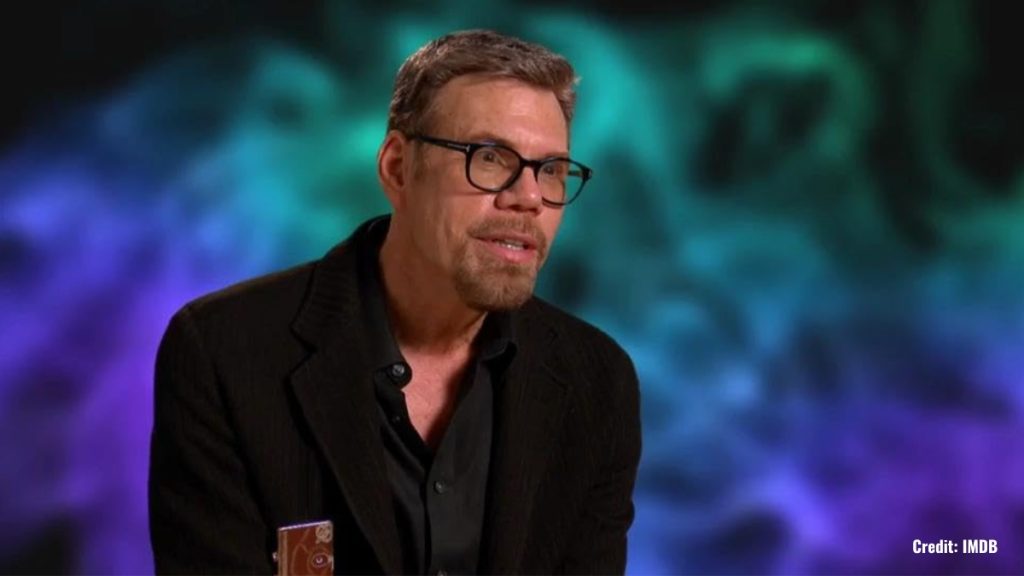
Katzenberg saw the patriotic appeal of the concept but ultimately passed on it, as he was focused on finding full-length feature projects for Disney’s animation department. Kirschner, undeterred, took his pitch elsewhere—to none other than Kathleen Kennedy, Steven Spielberg’s production partner. Kennedy was intrigued and invited Kirschner to Spielberg’s annual Fourth of July party to pitch the idea directly to the famed director.
Spielberg immediately saw the potential in Kirschner’s idea, but instead of a TV special, he envisioned a full-length animated feature film. This project would eventually become An American Tail, a tribute of sorts to Spielberg’s own grandfather, Philip Posner, who emigrated from Russia to the United States in the late 19th century. The film’s lead character, Fievel, was even named after Spielberg’s grandfather, whose Yiddish name was also Fievel.
Disney’s Loss Becomes Universal’s Gain
An American Tail went on to become a major success for Universal Pictures, which hadn’t been involved in an animated feature since the release of Pinocchio in Outer Space in 1965. Meanwhile, over at Disney, Eisner and Wells weren’t exactly thrilled that Katzenberg had let such a promising project slip through his fingers.
Not wanting to miss out on any future opportunities with Kirschner, Katzenberg quickly scheduled another meeting with him to discuss any other ideas he might have. And as fate would have it, Kirschner had just written a short story for Muppet Magazine called Halloween House, about a boy who is magically transformed into a cat by a trio of witches.
The Pitch That Sealed the Deal
Knowing Katzenberg could be a tough sell, Kirschner went all out to impress during his pitch. He requested access to the Disney lot 30 minutes early to set the stage for his presentation. When Katzenberg and the Disney development team walked into the conference room, they were greeted by a table covered in candy corn, a cauldron of dry ice fog, and a broom, mop, and vacuum cleaner suspended from the ceiling as if they were flying—evoking the magical world of Halloween House.
Katzenberg was reportedly unimpressed by the theatrical setup, muttering, “Oy, show-and-tell time” as he took his seat. But Kirschner knew exactly how to grab his attention. He started his pitch with the fact that Halloween was a billion-dollar business—a figure that made Katzenberg sit up and take notice. He listened attentively to Kirschner’s pitch, and by the time the meeting was over, Katzenberg was convinced. Halloween House would become Hocus Pocus, and Disney had its next big Halloween film.
A Bit of Hollywood Drama
Interestingly, Kirschner’s success with Hocus Pocus didn’t sit well with his old collaborators. About a year after the film’s release, Kirschner ran into Kathleen Kennedy at an Amblin holiday party, and she wasted no time in expressing her disappointment. According to Kirschner, Kennedy said, “You really hurt Steven.” When Kirschner asked how, she explained that Spielberg and Kennedy had given him his big break with An American Tail, but when he came up with the idea for his next film, he brought it to Disney rather than to them.
Hollywood can be a place where loyalty is valued—or, at least, perceived loyalty. At the same time, this was happening just as Katzenberg was leaving Disney and partnering with Spielberg and David Geffen to launch DreamWorks SKG, which only added to the tension. Loyalty, as Kirschner found out, can be an abstract concept in the entertainment industry.
A Halloween Favorite is Born
Despite its rocky start at the box office in 1993, Hocus Pocus has gone on to become a beloved part of Halloween pop culture. And, as Carlin’s book details, its success helped pave the way for more Disney Halloween-themed projects in the years that followed.
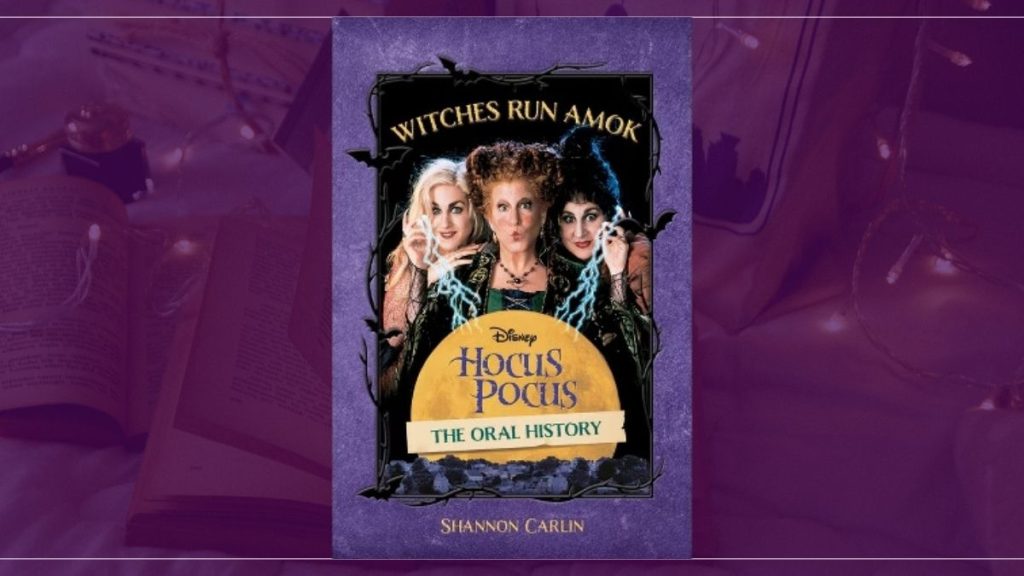
As for why Hocus Pocus was released in July of 1993 instead of during Halloween? That’s a story for another time, but it has something to do with another Halloween-themed project Disney was working on that year—Tim Burton’s The Nightmare Before Christmas—and Katzenberg finding himself in the awkward position of having to choose between keeping Bette Midler or Tim Burton happy.
For more behind-the-scenes stories about Hocus Pocus and other Disney films, be sure to check out Witches Run Amok by Shannon Carlin. It’s a fascinating read for any Disney fan!
And if you love hearing these kinds of behind-the-scenes stories about animation and film history, be sure to check out Fine Tooning with Drew Taylor, where Drew and I dive deep into all things movies, animation, and the creative decisions that shape the films we love. You can find us on your favorite podcast platforms or right here on JimHillMedia.com.
Film & Movies
How Disney’s “Bambi” led to the creation of Smokey Bear

When people talk about Disney’s “Bambi,” the scene that they typically cite as being the one from this 1942 film which then scarred them for life is – of course – the moment in this movie where Bambi’s mother gets shot by hunters.
Which is kind of ironic. Given that – if you watch this animated feature today – you’ll see that a lot of this ruined-my-childhood scene actually happens off-camera. I mean, you hear the rifle shot that takes down Bambi’s Mom. But you don’t actually see that Mama Deer get clipped.
Now for the scariest part of that movie that you actually see on-camera … Hands down, that has to be the forest fire sequence in “Bambi.” As the grown-up Bambi & his bride, Faline, desperately race through those woods, trying to find a path to safety as literally everything around them is ablaze … That sequence is literally nightmare fuel.
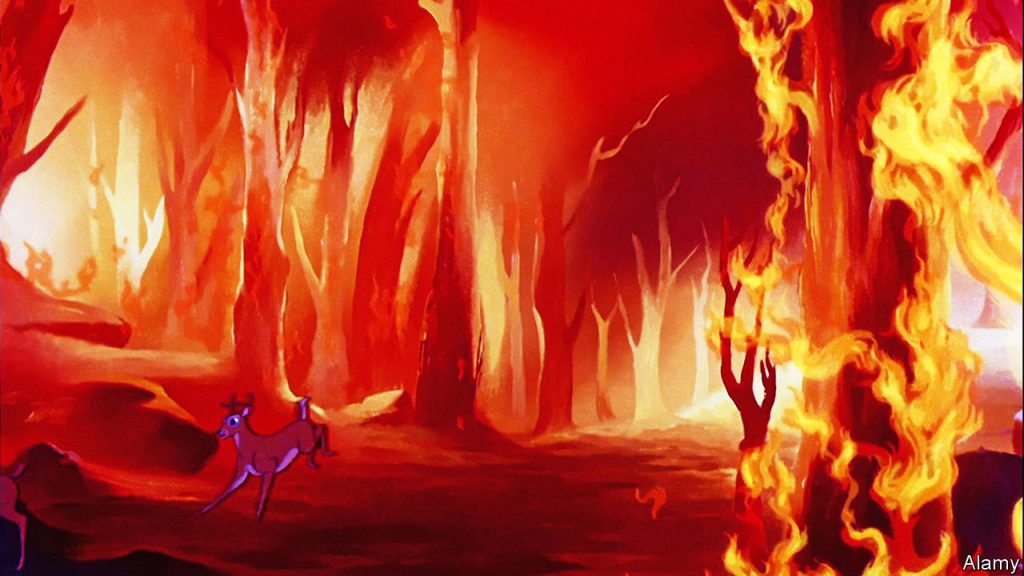
Mind you, the artists at Walt Disney Animation Studios had lots of inspiration for the forest fire sequence in “Bambi.” You see, in a typical year, the United States experiences – due to either natural phenomenon like lightning strikes or human carelessness – 100 forest fires. Whereas in 1940 (i.e., the year that Disney Studios began working in earnest of a movie version of Felix Salten’s best-selling movie), America found itself battling a record 360 forest fires.
Which greatly concerned the U.S. Forest Service. But not for the reason you might think.
Protecting the Forest for World War II
I mean, yes. Sure. Officials over in the Agricultural Department (That’s the arm of the U.S. government that manages the Forest Service) were obviously concerned about the impact that this record number of forest fires in 1940 had had on citizens. Not to mention all of the wildlife habitat that was now lost.
But to be honest, what really concerned government officials was those hundreds of thousands of acres of raw timber that had been consumed by these blazes. You see, by 1940, the world was on the cusp of the next world war. A conflict that the U.S. would inevitably be pulled into. And all that now-lost timber? It could have been used to fuel the U.S. war machine.
So with this in mind (and U.S. government officials now seeing an urgent need to preserve & protect this precious resource) … Which is why – in 1942 (just a few months after the Japanese bombed Pearl Harbor) – the U.S. Forest Service rolls out its first-ever forest fire prevention program.
Which – given that this was the early days of World War II – the slogan that the U.S. Forest Service initially chose for its forest fire prevention program is very in that era’s we’re-all-in-this-together / so-let’s-do-what-we-can-to-help-America’s war-effort esthetic – made a direct appeal to all those folks who were taking part in scrap metal drives: “Forest Defense is National Defense.”

And the poster that the U.S. Forest Service had created to support this campaign? … Well, it was well-meaning as well. It was done in the WPA style and showed men out in the forest, wielding shovels to ditch a ditch. They were trying to construct a fire break, which would then supposedly slow the forest fire that was directly behind them.
But the downside was … That “Forest Defense is National Defense” slogan – along with that poster which the U.S. Forest Service had created to support their new forest fire prevention program didn’t exactly capture America’s attention.
I mean, it was the War Years after all. A lot was going in the country at that time. But long story short: the U.S. Forest Service’s first attempt at launching a successful forest fire prevention program sank without a trace.
So what do you do in a situation like this? You regroup. You try something different.
Disney & Bambi to the Rescue
And within the U.S. government, the thinking now was “Well, what if we got a celebrity to serve as the spokesman for our new forest fire prevention program? Maybe that would then grab the public’s attention.”
The only problem was … Well, again, these are the War Years. And a lot of that era’s A-listers (people like Jimmy Stewart, Clark Gable, even Mel Brooks) had already enlisted. So there weren’t really a lot of big-name celebrities to choose from.
But then some enterprising official at the U.S. Forest Service came up with an interesting idea. He supposedly said “Hey, have you seen that new Disney movie? You know, the one with the deer? That movie has a forest fire in it. Maybe we should go talk with Walt Disney? Maybe he has some ideas about how we can better capture the public’s attention when it comes to our new forest fire prevention program?”
And it turns Walt did have an idea. Which was to use this government initiative as a way to cross-promote Disney Studio’s latest full-length animated feature, “Bambi.” Which been first released to theaters in August of 1942.
So Walt had artists at Disney Studio work up a poster that featured the grown-up versions of Bambi the Deer, Thumper the Rabbit & Flower the Skunk. As this trio stood in some tall grasses, they looked imploring out at whoever was standing in front of this poster. Above them was a piece of text that read “Please Mister, Don’t Be Careless.” And below these three cartoon characters was an additional line that read “Prevent Forest Fires. Greater Danger Than Ever!”
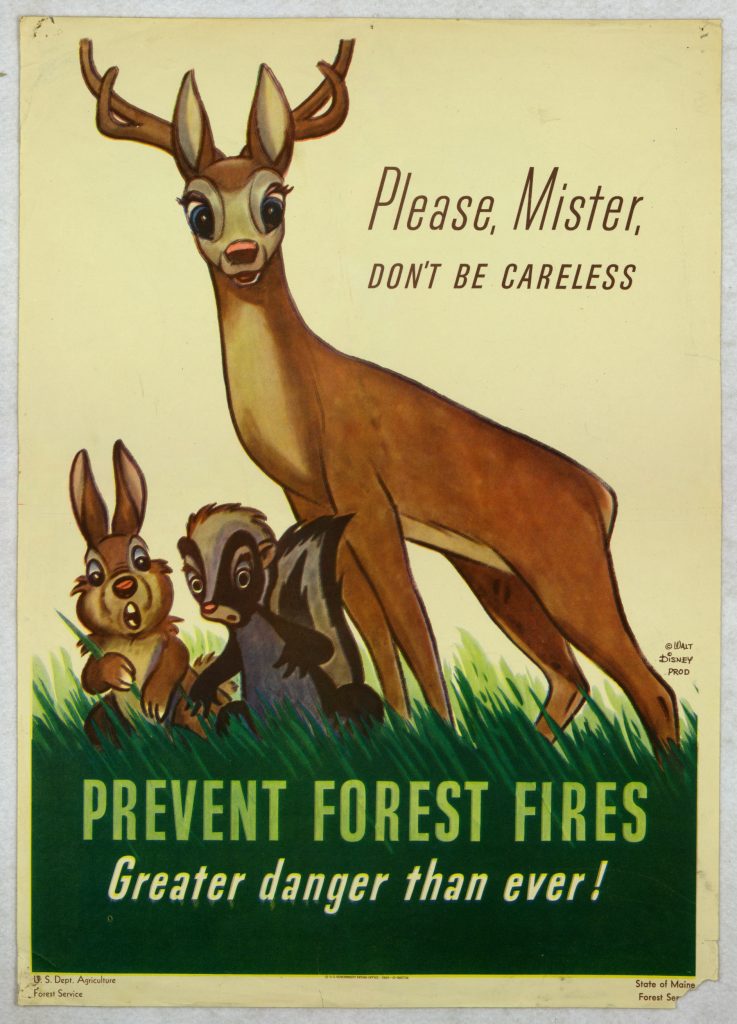
According to folks I’ve spoken with at Disney’s Corporate Archives, this “Bambi” -based promotional campaign for the U.S. Forest Service’s forest fire prevention campaign was a huge success. So much so that – as 1943 drew to a close – this division of the Department of Agriculture reportedly reached out to Walt to see if he’d be willing to let the U.S. Forest Service continue to use these cartoon characters to help raise the public’s awareness of fire safety.
Walt – for reasons known only to Mr. Disney – declined. Some have suggested that — because “Bambi” had actually lost money during its initial theatrical release in North America – that Walt was now looking to put that project behind him. And if there were posters plastered all over the place that then used the “Bambi” characters that then promoted the U.S.’s forest fire prevention efforts … Well, it would then be far harder for Mr. Disney to put this particular animated feature in the rear view mirror.
Introducing Smokey Bear
Long story short: Walt said “No” when it came to reusing the “Bambi” characters to promote the U.S. Forest Service’s forest fire prevention program. But given how successful the previous cartoon-based promotional campaign had been … Well, some enterprising employee at the Department of Agriculture reportedly said “Why don’t we come up with a cartoon character of our own?”
So – for the Summer of 1944 – the U.S. Forest Service (with the help of the Ad Council and the National Association of State Foresters) came up with a character to help promote the prevention of forest fires. And his name is Smokey Bear.
Now a lot of thought had gone into Smokey’s creation. Right from the get-go, it was decided that he would be an American black bear (NOT a brown bear or a grizzly). To make this character seem approachable, Smokey was outfitted with a ranger’s hat. He also wore a pair of blue jeans & carried a bucket.
As for his debut poster, Smokey was depicted as pouring water over a still-smoldering campfire. And below this cartoon character was printed Smokey’s initial catchphrase. Which was “Care will prevent 9 out of 10 forest fires!”
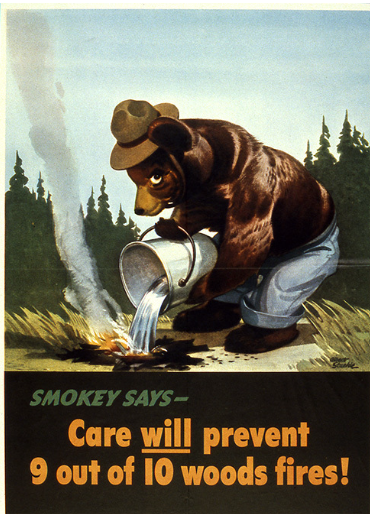
Which makes me think that this slogan was written by the very advertising executive who wrote “Four out of five dentists recommend sugarless gum for their patients who chew gum.”
Anyway … By the Summer of 1947, Smokey got a brand-new slogan. The one that he uses even today. Which is “Only YOU can prevent forest fires.”
The Real Smokey Bear
Now where this gets interesting is – in the Summer of 1950 – there was a terrible forest fire up in the Capitan Mountains of New Mexico. And over the course of this blaze, a bear cub climbed high up into a tree to try & escape those flames.
Firefighters were finally able to rescue that cub. But he was so badly injured in that fire that he was shipped off to the National Zoo in Washington, D.C. and nursed back to health. And since this bear really couldn’t be released back in the wild at this point, he was then put on exhibit.
And what does this bear’s keepers decide to call him? You guessed it: Smokey.
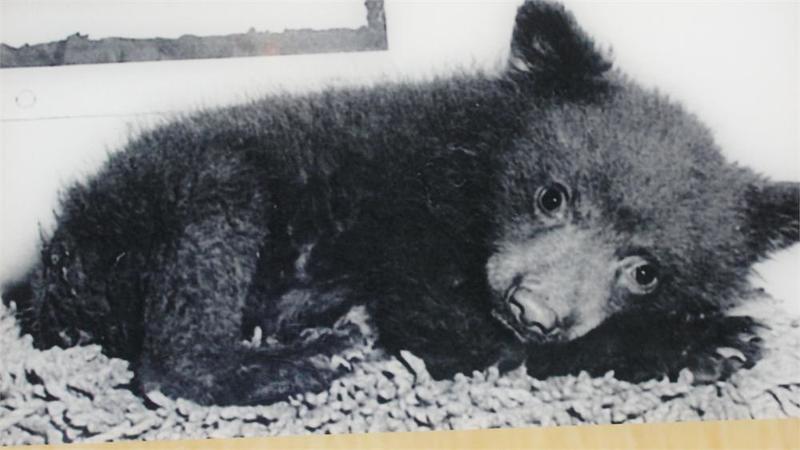
And due to all the news coverage that this orphaned bear got, he eventually became the living symbol of the U.S. Forest Service’s forest fire prevention program. Which then meant that this particular Smokey Bear got hit with a ton of fan mail. So much so that the National Zoo in Washington D.C. wound up with its own Zip Code.
“Smokey the Bear” Hit Song
And on the heels of a really-for-real Smokey Bear taking up residence in our nation’s capital, Steve Nelson & Jack Rollins decide to write a song that shined a spotlight on this fire-fightin’ bruin. Here’s the opening stanza:
With a ranger’s hat and shovel and a pair of dungarees,
You will find him in the forest always sniffin’ at the breeze,
People stop and pay attention when he tells them to beware
Because everybody knows that he’s the fire-preventin’ bear
Believe or not, even with lyrics like these, “Smokey the Bear” briefly topped the Country charts in the Summer of 1950. Thanks to a version of this song that was recorded by Gene Autry, the Singing Cowboy.
By the way, it was this song that started all of the confusion in regards to Smokey Bear’s now. You see, Nelson & Rollins – because they need the lyrics of their song to scan properly – opted to call this fire-fightin’-bruin Smokey THE Bear. Rather than Smokey Bear. Which has been this cartoon character’s official name since the U.S. Forest Service first introduced him back in 1944.
“The Ballad of Smokey the Bear”
Further complicating this issue was “The Ballad of Smokey the Bear,” which was a stop-motion animated special that debuted on NBC in late November of 1966. Produced by Rankin-Bass as a follow-up to their hugely popular “Rudolph the Red-Nosed Reindeer” (which premiered on the Peacock Network in December of 1964) … This hour-long TV show also put a “THE” in the middle of Smokey Bear’s name because the folks at Rankin-Bass thought his name sounded better that way.
And speaking of animation … Disney’s “Bambi” made a brief return to the promotional campaign for the U.S. Forest Service’s forest fire prevention program in the late 1980s. This was because the Company’s home entertainment division had decided to release this full-length animated feature on VHS.
What’s kind of interesting, though, is the language used on the “Bambi” poster is a wee different than the language that’s used on Smokey’s poster. It reads “Protect Our Forest Friends. Only You Can Prevent Wildfires.” NOT “Forest Fires.”
Anyway, that’s how Disney’s “Bambi” led to the creation of Smokey Bear. Thanks for bearin’ with me as I clawed my way through this grizzly tale.
Film & Movies
“Indiana Jones and the Search for Indiana Jones”
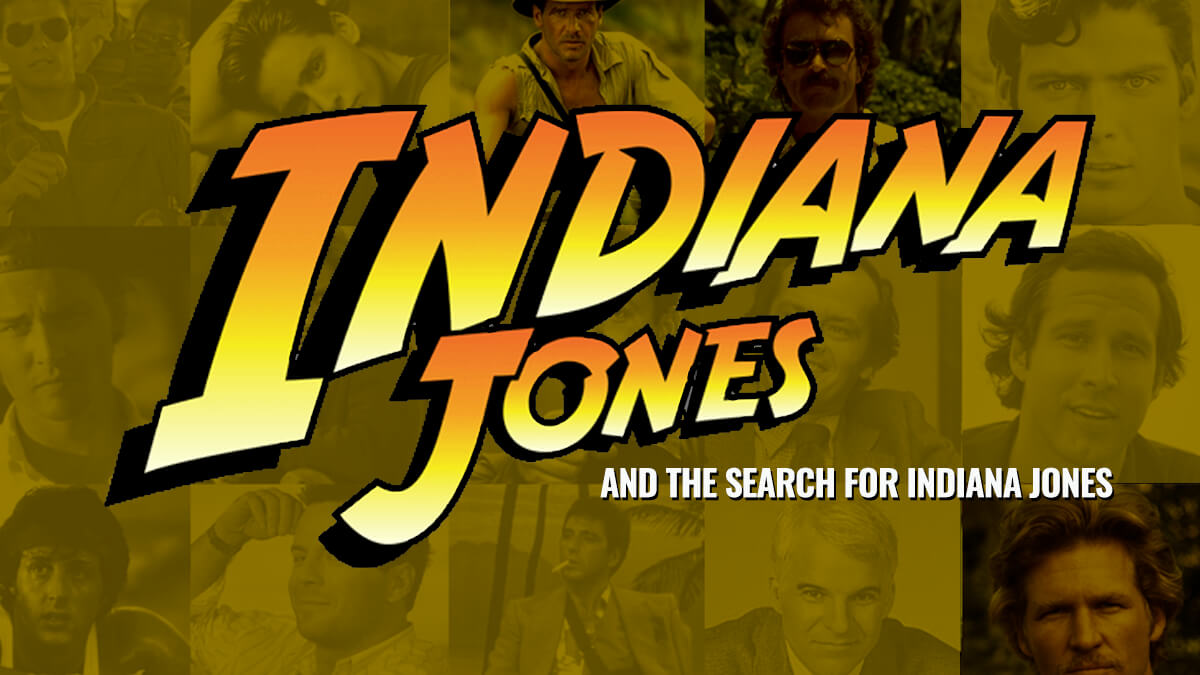
News came late last week that NBC was cancelling the “Magnum PI” remake. This series (which obviously took its inspiration from the Tom Selleck show that originally debuted on CBS back in December of 1980 and then went on run on that network for 8 seasons. With its final episode airing on May 8, 1988).
Anyway … Over 30 years later, CBS decided to remake “Magnum.” This version of the action drama debuted on September 24, 2018 and ran for four seasons before then being cancelled. NBC picked up the “Magnum” remake where it ran for one more season before word came down on June 23rd that this action drama was being cancelled yet again.
FYI: The second half of Season 5 of “Magnum” (10 episodes) has yet to air on NBC. It will be interesting to see when that final set of shows / the series finale gets scheduled.
This all comes to mind this week – out ahead of the theatrical release of “Indiana Jones and the Dial of Destiny” because … Well, if CBS execs had been a bit more flexible back in 1980, the star of the original version of “Magnum PI” (Tom Selleck) would have played the lead in “Raiders of the Lost Ark.” Which was released to theaters back on June 12, 1981.
That’s the part of the Indiana Jones story that the folks at Lucasfilm often opt to skim over.
That Harrison Ford wasn’t George Lucas’ first choice to play Doctor Jones.
Auditions for Indiana Jones – Harrison’s Not on the List
Mind you, Steven Spielberg – right from the get-go – had pushed for Ford to play this part. The way I hear it, Lucas showed Spielberg a work-in-progress cut of “The Empire Strikes Back.” And Steven was so taken with Harrison’s performance as Han Solo in that Irwin Kershner film that he immediately began pushing for Ford to be cast as Doctor Jones.
Whereas Mr. Lucas … I mean, it wasn’t that George had anything against Harrison. What with Ford’s performances first in “American Grafitti” and then in “A New Hope,” these two already had a comfortable working relationship.
But that said, Lucas was genuinely leery of … Well, the sort of creative collaboration that Martin Scorcese and Robert DeNiro. Where one actor & one director repeatedly worked together. To George’s way of thinking, that was a risky path to follow. Hitching your wagon to a single star.
Which is why – when auditions got underway for “Raiders of the Lost Ark” in 1979 — Mike Fenton basically brought in every big performer of that era to read for Dr. Jones except Harrison Ford. We’re talking:
- Steve Martin
- Chevy Chase
- Bill Murray
- Jack Nicholson
- Peter Coyote
- Nick Nolte
- Sam Elliot
- Tim Matheson
- and Harry Hamlin
Casting a Comedian for Indiana Jones
Please note that there are a lot of comedians on this list. That’s because – while “Raiders of the Lost Ark” was in development — Spielberg was directed his epic WWII comedy, “1941.” And for a while there, Steve & George were genuinely uncertain about whether the movie that they were about to make would be a sincere valentine to the movie serials of the 1930s & the 1940s or more of a spoof.
It’s worth noting here that three of the more ridiculous set pieces found in “Temple of Doom” …
- the shoot-out at Club Obi Wan in Shanghai
- Indy, Willie & Short Round surviving that plane crash by throwing an inflatable life raft out of the cargo hatch
- and that film’s mine cart chase (which was not only inspired by Disney theme park favorites the Matterhorn Bobsleds & Big Thunder Mountain Railroad but some of the sound effects that you hear in this portion of “Temple of Doom” were actually recorded after hours at Disneyland inside of these very same attractions)
… all originally supposed to be in “Raiders of the Lost Ark.” I’ve actually got a copy of the very first version of the screenplay that Lawrence Kasdan wrote for the first “Indy” movie where all three of these big action set pieces were supposed to be part of the story that “Raiders” told. And I have to tell you that this early iteration of the “Raiders” screenplay really does read more like a spoof of serials than a sincere, loving salute to this specific style of cinema.
Casting Indiana Jones – Jeff or Tom
Anyway … Back now to the casting of the male lead for “Raiders” … After seeing virtually every actor out in LA while looking for just the right performer to portray Indiana Jones, it all came down to two guys:
- Jeff Bridges
- and Tom Selleck
Jeff Bridges as Indiana Jones
Mike Fenton was heavily pushing for Jeff Bridges. Having already appeared with Clint Eastwood in 1974’s “Thunderbolt & Lightfoot” (Not to mention that “King Kong” remake from 1976), Bridges was a known quantity. But what Fenton liked especially liked about Bridges when it came to “Raiders” was … Well, at that time, Jeff was just coming off “Heaven’s Gate.”
Mind you, nowadays, because we’ve all now had the luxury of seeing the director’s cut of this Michael Cimino movie, we recognize “Heaven’s Gate” for the cinematic masterpiece that it is. But 40+ years ago, that honestly wasn’t the case. All audiences had to judge this movie by was the severely truncated version that United Artists sent out into theaters. Which – because “Heaven’s Gate” had cost $44 million to make and only sold $3.5 million of tickets – then became the textbook example of Hollywood excess.

Long story short: Given that being associated with “Heaven’s Gate” had somewhat dinged Bridges’ reputation for being a marketable star (i.e., a performer that people would pay good money to see up on the big screen), Jeff was now looking to appear in something highly commercial. And the idea of playing the lead in a film directed by Steven Spielberg (the “Jaws” & “Close Encounter” guy) and produced by George Lucas (Mr. “Star Wars”) was very, very appealing at that time. Bridges was even willing to sign a contract with Spielberg & Lucas that would have then roped him into not only playing Indiana Jones in “Raider of the Lost Ark” but also to appear as this very same character in two yet-to-be-written sequels.
Better yet, because “Heaven’s Gate” had temporarily dimmed Bridges’ star status, Jeff was also willing to sign on to do the first “Indy” film for well below his usual quote. With the understanding that – should “Raiders of the Lost Ark” succeed at the box office – Bridges would then be paid far more to appear in this film’s two sequels.
That seemed like a very solid plan for “Raiders.” Landing a known movie star to play the lead in this action-adventure at a bargain price.
Ah, but standing in Mike Fenton’s way was Marcia Lucas.
Tom Selleck as Indiana Jones
Marcia Lucas, who had seen Tom Selleck’s audition for “Raiders” (And you can see it as well. Just go to Google and type in “Tom Selleck” and “Indiana Jones.” And if you dig around for a bit, you’ll then see a feature that Lucas & Spielberg shot for “Entertainment Tonight” back in 2008 [This story was done in support of the theatrical release of “Indiana Jones and the Kingdom of the Crystal Skull”]. And as part of this piece, George and Steve share Tom’s original audition for “Raiders.” And what’s genuinely fascinating about this footage is that Selleck’s scene partner is Sean Young. Who – at that time, anyway – was up for the role of Marion Ravenwood) and kept telling her husband, “You should cast this guy. He’s going to be a big star someday.”
And given that George was smart enough to regularly heed Marcia Lucas’ advice (She had made invaluable suggestions when it came to the editing of “American Graffiti” and the original “Star Wars.” Not to downplay George Lucas’ cinematic legacy, but Marcia Lucas was a world-class storyteller in and of her own right), Lucas then reached out to Spielberg and persuaded him that they should cast relative unknown Tom Selleck as Doctor Jones over the already well-known Jeff Bridges.
Now don’t feel too bad for Jeff Bridges. When he lost out on playing the lead in “Raiders of the Lost Ark,” Jeff then accepted a role in the very next, high profile, sure-to-be-commercial project that came along. Which turned out to be Disney’s very first “TRON” movie. Which was eventually released to theaters on July 9, 1982.
Back to Tom Selleck now … You have to remember that – back then – Selleck was the handsome guy who’d already shot pilots for six different shows that then hadn’t gone to series. Which was why Tom was stuck being the guest star on shows like “The Fall Guy” and “Taxi.” Whereas once word got out around town that Selleck was supposed to play the lead in a project that Spielberg was directed & Lucas was producing … Well, this is when CBS decided that they’d now take the most recent pilot that Tom had shot and then go to series with this show.
That program was – of course – the original “Magnum PI.” And it’s at this point where our story started to get complicated.
“Magnum PI” – Two Out of Three Say “Yes”
Okay. During the first season of a TV show, it’s traditionally the network – rather than the production company (which – in this case – was Glen A. Larson Productions. The company behind the original versions of “Battlestar Galactica” & “Knight Rider”) or the studio where this series is actually being shot (which – in this case – was Universal Television) that has all the power. And in this particular case, the network execs who were pulling all the strings behind-the-scenes worked for CBS.
And when it came to the first season of “Magnum PI,” CBS had a deal with Glen A. Larson Productions and Universal Television which stated that the talent which had been contracted to appear in this new action drama would then be available for the production of at least 13 episodes with an option to shoot an additional 9 episodes (This is known in the industry as the back nine. As in: the last nine holes of a golf course).
Anyway, if you take those initial 13 episodes and then tack on the back nine, you then get 22 episodes total. Which – back in the late 1970s / early 1980s, anyway – was what a full season of a network television show typically consisted of.
Anyway … The contract that Selleck had signed with Glen A. Larson Productions, Universal Television & CBS stated that he had to be available when production of Season One of “Magnum PI” began in March of 1980. More to the point, Tom also had to be available should CBS exercise its option to air 22 episodes of this new series on that television network over the course of “Magnum PI” ‘s first season.
Which then made things complicated for George Lucas & Steven Spielberg because … Well, in order for “Raiders of the Lost Ark” to make its June 12, 1981 release date, that then meant that production of the first “Indy” movie would have to get underway no later than June 23, 1980.
But here’s the thing: Production of Season One of “Magnum PI” was scheduled to run through the first week of July of that same year (1980). So in order for Tom Selleck to play Indiana Jones in “Raiders,” he was going to need to be wrapped on production of “Magnum PI” by June 22, 1980 at the absolute latest.
So Spielberg & Lucas went to Glen A. Larsons Productions and asked if Selleck could please be sprung from his “Magnum PI” contractual obligations by June 22nd. And they said “Yes.” Then Steven & George went to Universal Television and asked executives there for their help in clearing Tom’s schedule so that he’d then be available to start work on “Raiders.” And they say “Yes” as well.
Spielberg & Lucas now go to CBS. But instead of the quick “Yeses” that they got from officials at Glen A. Larson Productions and Universal Television, it takes those suits at the Tiffany Network weeks before they then decided to say “No, they couldn’t release Tom Selleck early to go work on ‘Raiders’ “ because …
I’ve never really been able to get a straight answer here as to why CBS execs dug in their heels here. Why they flat-out refused to release Selleck early from his “Magnum PI” contractual obligation and allow him to go shoot “Raiders.”
Payback from “The Star Wars Holiday Special” Trash Talk
That said, it is worth noting that “The Star Wars Holiday Special” aired on CBS back in November of 1978. And given that – in the years that followed — Lucas wasn’t exactly shy when it came to saying how much he hated that two hour-long presentation (Or – for that matter – how George really regretted caving into the requests of CBS execs. Who had insisted that television stars long associated with the Tiffany Network – people like Art Carney, Harvey Korman & Bea Arthur – be given prominent guest starring roles in “The Star Wars Holiday Special”). And I’ve heard whispers over the years that CBS executives preventing Tom Selleck from appearing in “Raiders” could be interpreted as the Tiffany Network getting some payback for what George had said publicly about the “Star Wars Holiday Special.”

Harrison Ford Comes to Rescue “Indiana Jones”
Anyway … It’s now literally just weeks before production of “Raiders of the Lost Ark” is supposed to begin and Spielberg & Lucas have just learned that that they’ve lost their film’s star. CBS is flat-out refusing to release Tom Selleck early from his “Magnum PI” contractual obligation. So Steven & George now have to find someone else to play Indy … and fast.
The real irony here is … The American Federation of Television and Radio Artists would go on strike in the Summer of 1980. Which then shut prematurely shut down production of the first season of “Magnum PI.” (As a direct result, the first full season of this action drama to air on CBS only had 18 episodes, rather than the usual 22). And because this job action lasted ‘til October 23rd of that same year … Well, this meant that Tom Selleck would have actually been free to start shooting “Raiders of the Lost Ark” on June 23, 1980 because production of Season One of “Magnum PI” was already shut down by then due to that AFTRA strike.
But no one knew – in May of 1980, anyway – that this job action was going to happen in just a few weeks. All that Steven Spielberg & George Lucas knew was that they now needed a new lead actor for “Raiders.” And circling back on Jeff Bridges was no longer an option. As I mentioned earlier, Jeff had agreed to do “TRON” for Disney. And – in the interim – Bridges gone off to shoot “Cutter’s Way” for MGM / UA.
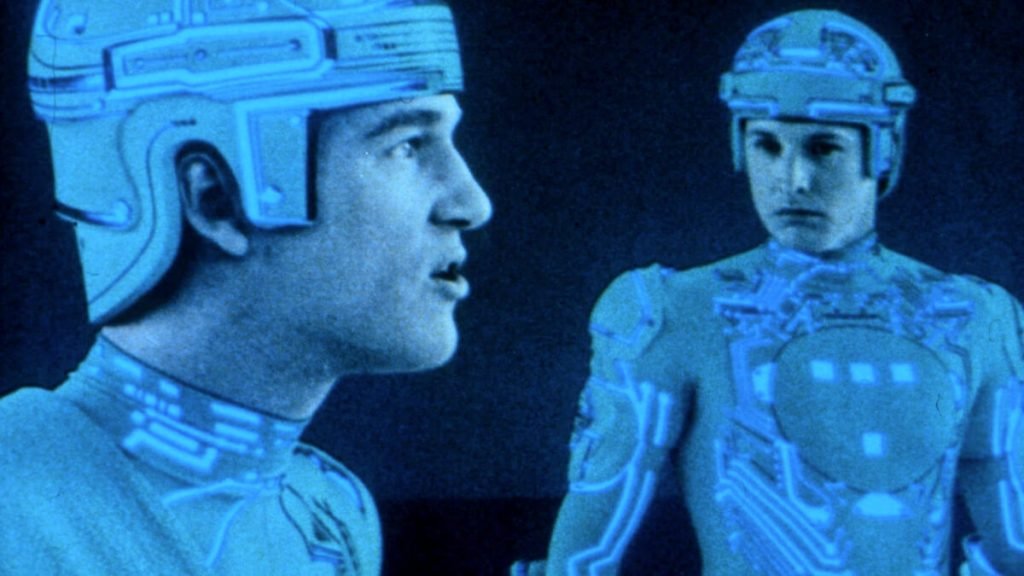
So this is where Harrison Ford enters the equation. As he recalls:
In May of 1980, I get a call from George Lucas. Who says ‘I’m messaging a script over to you this morning. As soon as it gets there, I need you to immediately read this script. Then – as soon as you’re done – I need you to call.
So the script arrives and it’s for ‘Raiders.’ I read it and it’s good. So I call George back and say ‘It’s good.’ And he then says ‘Would you be interested in playing Indy?’ I say that it looks like it would be a fun part to play.
George then says ‘ That’s great to hear. Because we start shooting in four weeks. Now I need you to meet with Steven Spielberg today and convince him that you’re the right guy to play Indy.’
Of course, given that Spielberg had been pushing for Ford to pay Indy ever since he had first seen that work-in-progress version of “The Empire Strikes Back” … Well, Harrison’s meeting with Steven was very, very short. And just a few weeks later, Spielberg, Lucas & Ford were all at the Port de la Pallice in La Rochelle. Where – on the very first day of shooting on “Raiders” (which – again – was June 23, 1980)– the scene that was shot was the one where that Nazi sub (the one that Indy had lashed himself to its periscope by using his bullwhip as a rope) was arriving at its secret base.
And all of this happened because Harrison immediately agreed to do “Raiders of the Lost Ark” when the part of Indy was first offered to him in mid-May of 1980.
Before “Star Wars” was “Star Wars”
So why such a quick yes? Well, you have to remember that “Empire Strikes Back” wouldn’t be released to theaters ‘til May 21, 1980. And no one knew at that time whether this sequel to the original “Star Wars” would do as well at the box office as “A New Hope” had back in 1977 (FYI: “Empire” would eventually sell over $500 million worth of tickets worldwide. Which is roughly two thirds of what the original “Star Wars” earned three years earlier).
More to the point, the four films that Harrison had shot right after “A New Hope” / prior to “Empire Strikes Back” (i.e., “Heroes” AND “Force 10 from Navarone” AND “Hanover Street” AND “The Frisco Kid”) had all under-performed at the box office. So to Ford’s way of thinking, taking on a role that Tom Selleck was no longer available to play – one that had the potential of spawning two sequels – seemed like a very smart thing to do. Especially after three years of cinematic stumbles.
By the way, whenever this topic ever comes up, Harrison Ford is very gracious. He always makes a point of saying that he’s grateful to have gotten this career opportunity. More to the point, that he still feels kind of bad that Tom Selleck never got the chance to play this part.
Tom Selleck After “Indiana Jones”
That said, we shouldn’t feel too bad for Tom Selleck. After all, the original “Magnum PI” proved to be a long running hit for CBS. And in an effort to smooth over any residual bad feelings that may have resulted from Tom being forced to give up “Raiders” back in May of 1980, Selleck was eventually allowed to create his own production company (i.e., T.W.S. Productions, Inc. As in Thomas William Selleck Productions). Which – after the fact – was then cut in on some of those “Magnum PI” -related revenue streams.
More to the point, while “Magnum PI” was on hiatus following its second year in production, Selleck flew off to Yugoslavia. Where he then shot his own Indiana Jones-esque film for theatrical release. Which was called “High Road to China” in the States, but – overseas – was promoted as “Raiders of the End of the World.”
FYI: Warner Bros. released “High Road to China” stateside 40 years ago this year. On March 18, 1983, to be exact. It didn’t do all that great at the box office. $28 million in ticket sales versus $15 million in production costs.
And over the years, there’s even been some talk of finding a way to maybe set things right here. By that I mean: Finally finding a way to officially fold Tom Selleck into the world of Indiana Jones.
Could Tom Selleck Work with Indiana Jones?
The way I hear it, between the time when “Indiana Jones and the Last Crusade” was theatrically released in May of 1989 and when “Indiana Jones and the Kingdom of the Crystal Skull” debuted in May of 2008, there were a number of ideas for Indiana Jones sequels tossed around. And from what I’ve been told, there was at least one treatment for a fourth Indiana Jones film written that proposed pairing up Harrison Ford & Tom Selleck. With the idea here being that Selleck was supposed to have played Ford’s brother.
Obviously that film was never made. And – no – I don’t know what state Indiana Jones’ brother was supposed to be named after.
This article is based on research for Looking at Lucasfilm “Episode 80”, published on June 29, 2023. Looking at Lucasfilm is part of the Jim Hill Media Podcast Network.
-
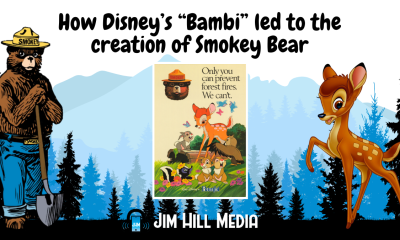
 Film & Movies11 months ago
Film & Movies11 months agoHow Disney’s “Bambi” led to the creation of Smokey Bear
-

 Merchandise12 months ago
Merchandise12 months agoIntroducing “I Want That Too” – The Ultimate Disney Merchandise Podcast
-

 Theme Parks & Themed Entertainment6 months ago
Theme Parks & Themed Entertainment6 months agoDisney’s Forgotten Halloween Event: The Original Little Monsters on Main Street
-

 Theme Parks & Themed Entertainment7 months ago
Theme Parks & Themed Entertainment7 months agoThe Story of Mickey’s Not-So-Scary Halloween Party: From One Night to a Halloween Family Tradition
-

 Film & Movies7 months ago
Film & Movies7 months agoHow “An American Tail” Led to Disney’s “Hocus Pocus”
-

 Theme Parks & Themed Entertainment5 months ago
Theme Parks & Themed Entertainment5 months agoDisney and Macy’s 90-Year Thanksgiving Day Parade Partnership: From Mickey’s First Balloon to Minnie’s Big Debut
-

 Television & Shows3 months ago
Television & Shows3 months agoHow the Creators of South Park Tricked A-List Celebrities to Roast Universal – “Your Studio & You”
-

 History2 months ago
History2 months agoThe Super Bowl & Disney: The Untold Story Behind ‘I’m Going to Disneyland!’



